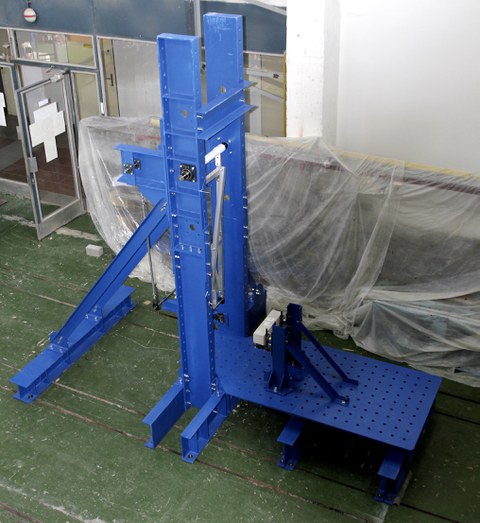UHPFRC under high strain rates
Table of contents
Project data
| Titel | Title Beschreibung und experimentelle Untersuchung von UHPFRC unter hohen Verzerrungsraten | Formulation of Ultra High Performance Fibre Reinforced Concrete - UHPFRC and Its Testing Under High Strain Rates Förderer | Funding DAAD | Ministry of the Interior of the Czech Republic Zeitraum | Period 01/2010 – 09/2014 Leiter | Project manager Prof. Ing. Petr Konvalinka, CSc. Bearbeiter | Contributor Ing. Petr Máca |
Report in the yearbook 2012
On impact testing of concrete

Impact machine at CTU in Prague – pendulum principle
This experimental work is part of a bigger project that is focused on studying the concrete behaviouar under different strain-rates. The basis of the project is development and experimental testing of ultra-high performance fibre reinforced concrete (UHPFRC). Both static and impact behaviour of this new material is compared with normal strength concrete, high strength concrete and fibre reinforced concrete.
Why impact loading? The behaviour and mechanical properties of concrete under quasi-static conditions is pretty well documented. However, there is only limited knowledge about behaviour under high strain rates – i.e. impact loading such as vehicle crash or pressure waves caused by explosion. To assess the energy absorption capacity (EAC) of the material an impact loading machine is used. The principle of this experiment is easy: a weight hits a concrete prism with a speed around 20 km/h and an impact force and acceleration are measured. Afterwards, deflection of the prisms is calculated by integrating the acceleration of the specimen. The EAC is then calculated as an area under the stress-strain curve. It was found that the UHPFRC is capable of dissipating more energy compared to the other tested materials. This can be explained by the synergic effect of high-strength matrix and short steel fibres.
Why is it done in Dresden? For this type of measurements, there are no existing guidelines or recommendations. So, every research team uses its own methodology to investigate the impact resistance of concrete and their results are highly machine and lab specific. In this project the same samples were tested on two impact machines working on different principles. The machine at TU Dresden is based on the principle of guided weight falling down from a given height on the concrete prism. The specimen is then loaded vertically. The impact machine at CTU in Prague is based on the principle of a pendulum: an impactor is following a circular trajectory and is loading the specimen horizontally. Because the size of samples and the material used are the same, this research should answer the question how big is the influence of the type of loading mechanism and if the results are comparable.
